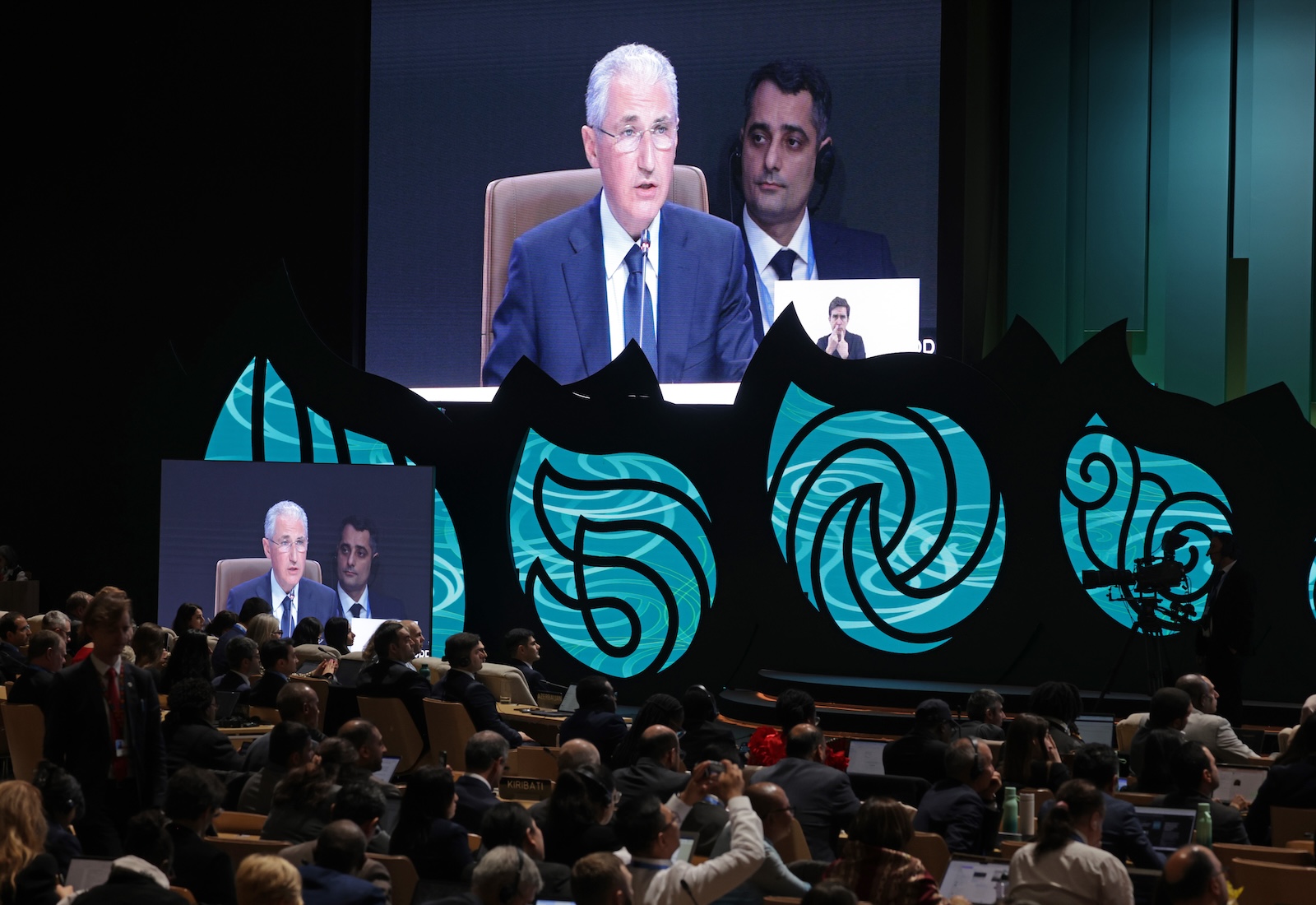Delegates closed out this year’s United Nations climate conference on Saturday after agonizing debates on the right way to deliver on the goals of the 2015 Paris Agreement. In addition to approving a new framework for international climate aid, nearly 200 countries approved guidelines meant to make it cheaper and easier for them to reach their emissions reduction targets by trading in international carbon markets — in essence, allowing one country to pay another to make emissions cuts on its behalf. While some delegates applauded these developments, many experts and environmental groups are unhappy with the final agreement.
Among the flaws observers identified were a lack of transparency in the way countries count and report carbon credits and the absence of concrete consequences when agreed-upon guidelines aren’t followed. The final guidelines also failed to provide much specificity about the types of projects allowed to create carbon credits.
Carbon Market Watch, a European watchdog and research group, said in a statement that the agreements reached at the end of the conference risked “facilitating cowboy carbon markets at a time when the world needs a sheriff.”
The carbon markets in question have to do with Article 6 of the Paris Agreement. First outlined in 2015, the article imagined three ways for countries to reduce their greenhouse gas emissions cooperatively. Fleshing out the details, however, has remained the subject of contention through multiple COPs, the name for the annual climate meetings held by the United Nations.
Article 6’s first cooperative approach, under Article 6.2, allows countries to bilaterally trade carbon credits known as “internationally transferred mitigation outcomes” — certificates each representing 1 metric ton of carbon emissions that are prevented or removed from the atmosphere. The second approach, described in Article 6.4, envisions a global market for carbon credits — in this case dubbed “emission reduction units” — that are purchasable by governments and companies alike. Article 6.8 highlights nonmarket approaches, the third cooperative carbon-reduction mechanism. It wasn’t discussed much at COP29, but it’s supposed to create a platform for wealthy countries to donate money or climate technology to poorer countries.
According to the International Emissions Trading Association, a pro-carbon market industry group, Articles 6.2 and 6.4 could reduce the cost of reaching countries’ emissions targets by up to $250 billion a year by 2030, since they incentivize countries to do the least expensive emissions reductions first. Simon Watts, New Zealand’s climate minister, said in a statement that the decision to greenlight Article 6 “sends a clear signal to the market to unlock investments in activities that reduce emissions and enable countries to be able to work together and support each other to meet their climate targets.”
Critics, however, say carbon trading mechanisms distract wealthy countries from the essential work of reducing their own emissions. They say Article 6 risks replicating some of the same fraud and human rights issues that have tainted existing carbon markets outside of the U.N.’s purview.
The first big piece of news out of COP29, this year’s U.N. climate conference in Baku, Azerbaijan, was about Article 6.4, the global carbon market for countries and businesses. On November 11, the opening day of the summit, delegates approved two key documents to make the market work, and countries are now expected to begin using it as early as mid-2025.
COP29 President Mukhtar Babayev touted the market’s fast-tracked approval as a breakthrough “following years of stalemate,” an apparent attempt to set a positive tone for the rest of the two-week conference. But the announcement obscured broader disagreements over Article 6.
Sean Gallup / Getty Images
One reason for conflict is that COP29’s initial agreements over Article 6.4 were not reached through negotiation. Rather, they were reached through a procedural sleight of hand by the Article 6.4 Supervisory Body, the 12-person technical group charged with designing standards for the new carbon market. Instead of asking national delegates to weigh in on and approve those two key documents, the Supervisory Body unilaterally adopted them in October and asked delegates to rubber-stamp them at COP29.
The texts that were pushed through outline the types of carbon removal projects that are allowed to generate carbon credits, and the methodologies used to determine how much a carbon credit is worth.
Isa Mulder, an expert on global carbon markets for Carbon Market Watch, said the move sets a dangerous precedent for the Supervisory Body — and potentially other technical groups — to push forward controversial texts without submitting them to delegates for discussion or negotiation.
Similar fears were raised by a host of other observers, as well as the delegate from Tuvalu. Erika Lennon, a senior attorney from the nonprofit Center for International Environmental Law, called it in a statement a “rogue move from the Supervisory Body to prevail in the quest to start COP29 with a ‘win.’”
Critics voiced not only procedural concerns, but also substantive ones. Lennon criticized the Supervisory Body’s guidance for being too vague about the types of carbon projects allowed to generate credits — some projects, like storing carbon in rocks, are more reliable than others — and for failing to set monitoring requirements that ensure against “reversal,” the release of carbon that was supposed be locked up in perpetuity (like when a wildfire burns up a forest).
“Governments now face the real possibility of having created a Paris-sanctioned carbon market that could be worse for people and the planet than the scandal-ridden voluntary carbon markets,” she said, referring to the unregulated marketplace that companies already use to claim they’ve offset their greenhouse gas emissions.
Injy Johnstone, a decarbonization research associate at the University of Oxford, said a lack of transparency and accountability could allow countries to exaggerate their emissions reductions achieved through offsets.
“Where there are loopholes, they will be exploited,” she said.
As negotiations closed on Sunday, those issues remained unresolved, along with others involving the transfer of credits from the Article 6.4 carbon market’s predecessor.
***
Article 6.2, the agreement allowing countries to bilaterally trade carbon credits, had already been in operation before COP29. Under what Lennon described as a “bare-bones” framework from the U.N., rich countries including Japan and Switzerland had set up agreements to exchange carbon credits with developing nations in order to claim progress toward their “nationally determined contributions” — the emissions-reduction pledges countries make under the Paris Agreement.
The aim for COP29 was to flesh out Article 6.2 rules on transparency and accountability, including how countries should authorize carbon credits, so that more countries could participate.
That didn’t happen — at least, not to the extent that some had hoped. Environmental groups and some negotiating blocs — notably, the EU — sounded the alarm over countries “moving backwards” in terms of the mechanism’s reliability. Near the end of the conference, Mulder said the 6.2 mechanism had been watered down so significantly that it risked becoming “just a framework where it’s completely up to countries to do whatever they want.”
The exact disagreements are deeply technical. One of the main disputes concerns language in the final text that “requests” — rather than mandates — that countries pause the use of carbon credits flagged for integrity issues by a U.N. technical body. Another part of the text makes it optional for countries to share certain details about their carbon trading activities, including carbon projects’ risk of reversal.

Dominika Zarzycka / SOPA Images / LightRocket via Getty Images
The agreed-upon texts “put a lot of weight on the shoulders of independent observers, researchers, the media, and the countries themselves to scrutinize the actions of countries engaging in Article 6.2,” said Jonathan Crook, a policy expert at Carbon Market Watch, in a statement. Crook observed that the complexity of Article 6 will likely hinder would-be watchdogs from holding countries accountable for trading low-quality credits.
Last week, during the final days of COP29, an investigation from the Swiss nonprofit Alliance Sud highlighted the risks of nontransparency around Article 6.2’s carbon credits. It found that Switzerland’s agreement to offset its greenhouse gas emissions by selling clean-burning cookstoves to Ghana — facilitated by the pre-COP29 rules for Article 6.2 — was overestimating its climate benefits by up to 79 percent. But Alliance Sud was only able to discover this through Switzerland’s Freedom of Information Act; the project owner had initially refused to let the organization see an unredacted version of the project description, as well as the analysis used to calculate its emissions impact.
“The project is as opaque as dense fog,” Alliance Sud said. It concluded that “the possibility of public scrutiny remains crucial to ensuring that carbon mitigation projects do not endanger implementation of the Paris Agreement.”
With the Paris Agreement’s Article 6, some environmental advocates have found themselves in a tricky position. While they want to ensure the best outcome for its two market mechanisms, they also resent the fundamental idea of them.
“I get why people are there working on the minutiae of the text,” said Doreen Stabinsky, a professor of global environmental politics at the College of the Atlantic in Maine. “But for me the bigger story that needs to be told is that carbon markets don’t actually stop climate change.”
Just this month, an article in the journal Nature Communications found that fewer than 16 percent of carbon credits from more than 2,000 projects analyzed represented “real emission reductions.” On top of these integrity issues, Stabinsky said carbon markets incentivize rich countries to offset their emissions by funding mitigation projects in the developing world, rather than undertaking the difficult but necessary work of decarbonizing their own economies.
Lennon objected to the claim, often repeated at COP29, that carbon markets are a form of so-called “climate finance” — a term for much-needed funding for climate mitigation and adaptation in the developing world. An early draft of the COP29 agreement listed carbon markets as one of several types of climate finance that rich countries could funnel to poor countries.
“Carbon markets are not climate finance and should not be seen as climate finance,” she told Grist.
The explicit reference to carbon markets was struck from the final version of countries’ updated pledge to deliver $1.3 trillion to developing countries by 2035 — a main outcome of COP29. But the final agreement doesn’t prohibit countries from trying to use carbon markets to claim progress toward their financial obligations.
“The best-case outcome,” Lennon said, would be for the U.N. to eschew these markets altogether. A coalition of African environmental groups shared a similar sentiment during the final days of the COP29.
According to the groups, carbon markets “don’t actually decrease emissions; they just shift them around.” For that reason, they see them as a tool of the developed world to make it seem as if it is taking climate action, even as it appropriates more of the planet’s “carbon budget” — the amount of climate pollution that countries can collectively emit while remaining within safe planetary boundaries.
The groups “stand firmly against carbon markets, as we believe they can undermine the integrity of climate action and disproportionately impact developing nations,” they wrote.

